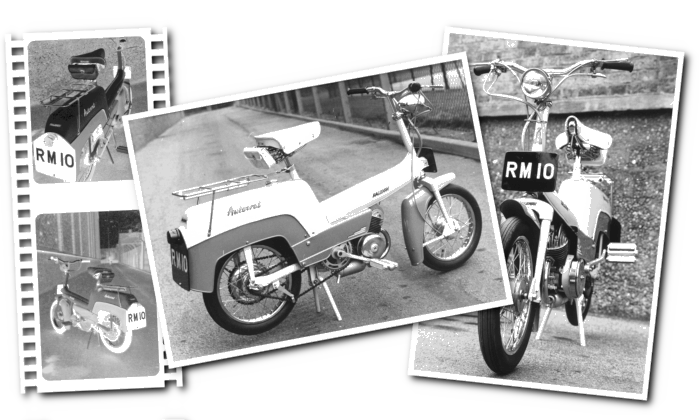The RM6 Runabout was introduced in May 1963, the RM8 MkII Automatic in December 1963, and the RM9 Ultramatic followed in April 1964.
Visually, all these 6, 8, & 9 single-seat Runabouts were pretty similar, so to indicate the distinctiveness of each model they could really only be painted in different colours; initially the RM6 was painted in a Raleigh Green & Pearl Grey (white) scheme, the RM8 in Charcoal Grey & Pearl Grey, and RM9 was finished in a Fire Red & Pearl Grey scheme.
Promotional blurb rated the original RM6 continuous-fin cylinder, 6.5:1 compression motor at 1.4bhp @ 4,500rpm, before switching to the newer up-rated split-fin cylinder, 7.5:1 compression motor of the RM8 rated at 1.7bhp @ 5,000rpm.
The RM9 had a variator, but exactly the same split-fin cylinder, 7.5:1 compression motor, and the same Gurtner AR10 carburettor, though a ‘blunderbuss’ exhaust system, which certainly isn’t going to account for the quoted power rating of 2bhp @ 5,000rpm. Raleigh marketing presumably wanted to present a higher power figure for the RM9 to justify its higher specification, but there’s nothing to support that the 2bhp claim could be at all real.
Fork shrouds similar to those fitted to the RM4 and a chain-guard were added to the RM9 around mid-1965, resulting in a type 2 variant of the model. The plastic moulded chain-guard was an addition probably prepared in anticipation of the forthcoming RM9+1, but it was hard to figure out what the purpose of putting the chain-guard on the RM9 single-seat models was.
The chain-guard was never considered for the RM6 or RM8, which were both based on the same frame and fitted with the same side-panels, so most likely the addition of the fork shrouds and chain-guard to the RM9 was just to give it further identifiable differences from the more basic 6 & 8 models.
Also announced in November 1965 was a new monotone colour scheme change for the RM9 to Polychromatic Golden Sand, which was introduced in the 1966 Raleigh catalogue.
The new RM9 Ultramatic Plus One model was announced in November 1966, and differentiated by the fitment of a dual-seat, pillion footrests, and stronger spokes in the rear wheel. Paintwork was finished in the same Golden Sand colour scheme and posted at a launch price of £73-3s-8d.

In January 1968 RM9 and RM9+1 introduced two new colour schemes: Royal Carmine Red (metallic), and Calypso Coffee, which comprised a dark brown polychromatic frame and forks with the rest in pearl grey (white). The Calypso Coffee combination was discontinued after just a few months, leaving the Royal Carmine Red to continue alone from March 1968.
So let’s have a look at our very special test subject…
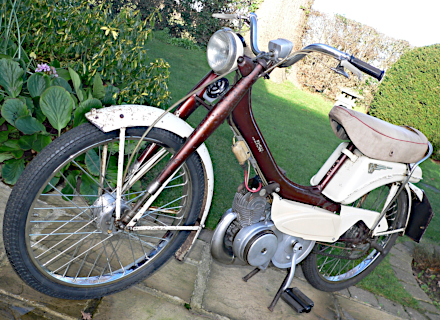
SPH 490F, Frame 023086, Engine R164337, finished in Calypso Coffee and, just to prove that official dating records may not always be accurate, we have the original VE60 green log book with our example, confirming it was registered on 27 November 1967, so this colour scheme was actually released earlier in preparation for the ’68 season.
The only difference between the RM9 frames and the RM9+1 frame was the addition of the saddle stem tube decal:

The single seat RM9 model was laced with 13-gauge (0.092") spokes front and rear, and while the RM9+1 uses the same 13G laced front wheel, the rear is built with heavier 11-gauge (0.116") spokes in the same hub and rim.
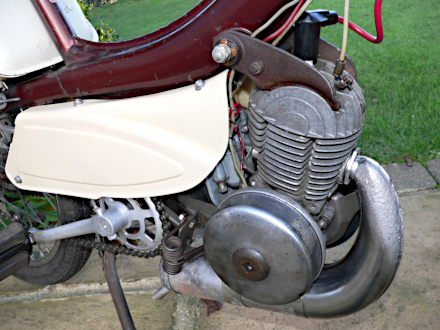
Though, saying that, while we’re more commonly used to seeing Raleigh using the Dunlop Endrick rims, we have noticed another 9+1 1968 model fitted with Sturmey–Archer branded Endrick pattern rims, which was a surprise, so it’s worth looking at the marking. Possibly the Sturmey–Archer may have been a heavier gauge rim, which was suggested in some references, but would require the wheels stripping down for comparative weight checks of the rims to confirm whether this might be true or false.
Tyre pressures for the RM9 are given as 25psi front & 40psi rear (hard rear for best performance?), so we can only presume the RM9+1 might be the same, because it seems no dedicated manual or spare parts lists were issued on the +1. We’re assuming the manuals were intended to be shared with the RM9, and we could only find part number references and descriptions to the specific +1 components in Moped Service Memorandum Series 2, Number 23, October 1967 (Re-issued September 1968).
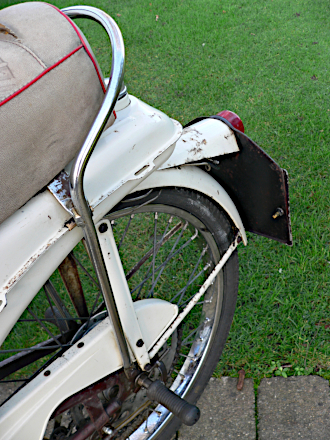
Rear footrests are machined from ⅝" hexagon solid steel bar and fitted with the same rubbers as the RM5, while the footrests screw directly onto the spindle to replace the standard rear wheel nuts. It’s a pity these rear footrests don’t fold up, because they’re always sticking out, unforgiving, and seemingly on a mission to damage your shins.
The dual seat is the same as fitted to the RM5, while the chrome plated rear saddle support loops above and behind the seat to serve as a convenient point for the rider to handle the bike by, and doubles-up as a grab-rail for the passenger to brace themselves against the blistering acceleration.
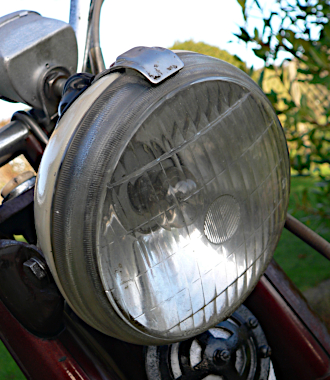
Our 9+1 is still fitted with its genuine Wipac S446 MES tail lamp, and an original 5-inch diameter Wipac 6V × 15/15W headlamp with integral glass rim as part of the lens. A broken lens is irreplaceable, and even though Wipac later superseded this lamp with a compatible and conventional chrome rim & glass lens arrangement, these are obsolete too. The original 5" glass rim & lens would probably have been cheaper to produce, and might possibly have made slightly better use of the generated light from the 4-inch diameter reflector, so we have try it out…
Turning the Wipac switch on top of the headlamp either side to H & L, and the High beam position works fine, but Low dip doesn’t light at all and just blows the tail bulb as all 18W from the generator fuse the 3W filament. Ooops! This is what happens when one headlamp filament is out when you turn it on, so following new bulbs each end, we hook up an external power supply for testing, and they all work now.
With the lights now fixed, and still on the power supply, we think to try the horn, but where’s the horn button? Ahhh, there’s a piece of wire poking through the brake lever bracket with a knotted end to stop it falling back though the hole, so touch the bare end on the handlebar: sparks, and the horn clatters—a simple switch!
The Wipac headlamp can’t accommodate a speedometer, so the only way to mount one of these was fitting the handlebar mounting Raleigh speedometer kit MTR115, comprising a 60mph Huret, speedo, and drive, or getting your local dealer to do that for you … which would have been E. Pascall (Guildford Ltd.) of 40 London Road, Camberley, who sold this bike to its first owner on 29th February 1968.
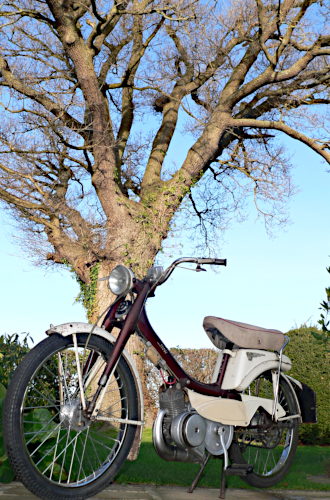
Our Calypso Coffee has all the mod-cons … so let’s see how it rides…
The familiar Raleigh starting procedure of fuel tap on at the bottom offside of tank, twist forward the Amal throttle to decompress, and pull in the choke trigger. It needs a firm kick forward on the pedal to overcome all the chain drive ratios and get the engine turning, then time it just right to twist back the throttle as the engine spins. The engine catches first time, then feather the choke trigger a couple more times until the motor runs freely—that was surprisingly easy!
Tick-over readily settles down to a regular beat, though the engine sounds a little more ‘mechanical’ that we’d normally expect, so maybe not 100%. Pull away is quite smart due to the lower starting ratio, and acceleration is a constant urge up the range as the variator smoothly progresses with the revs.
Our sat-nav pacer recorded the bike running consistently at 29–30mph sitting upright on the flat in still air, up to 31mph on flat in a crouch, and best of 32–33mph on a shallow downhill, while the Huret 60mph accessory kit speedo … didn’t work.
The big 100mm rear drum brake feels spongy at the lever and proves ineffective at stopping, probably new linings might be due. The smaller 80mm front brake worked the better of the two, but still felt as if the lever pressure required was disproportionate to the effect. The brakes would only become less effective with a passenger aboard and more weight to deal with. Handling was capable, the difference of the tele sprung fork set being more appreciated as the pace picks up on bumpy roads, in comparison to the rigid fork RM6 which would be jolting the living daylights out of you at this point. The dual-seat offers a significant improvement not only in absorbing feedback from the road surface through the rigid-rear frame, but also allowing the pilot more space to adjust their riding position, and particularly for adopting a more sporting crouch position.
The transformation that the variator makes can be appreciated by analysing the effect it has on the drive ratios. Where the RM6 Runabout has only a single-speed final drive ratio of 13.8:1, the RM9 variates from 18.74 (low) to 11.4 (high). This means that for pull away and hill-climbing the RM9 has a 35% lower ratio advantage, while the variator effects a 16.5% higher ratio for higher top speed, less revs, and better economy.
While the Ultramatic appears capable enough at pulling away and building up its mid-range speed with the aid of the variator, the 1.7bhp motor doesn’t seem to deliver enough power to pull any effective top speed. It’s generally capable enough to keep up with the pace in town traffic conditions, but considering that the 9+1 was also intended to carry a passenger, it might have worked out better for the task if it’d been fitted with the more powerful AV89 2.7bhp motor.
The RM9 Ultramatic Plus One model was announced in November 1966 in the Polychromatic Golden Sand colour, which was effective until end December 1967 when the Royal Carmine Red scheme and the Calypso Coffee combination colour scheme replaced it.
So where did the coffee colour come from?
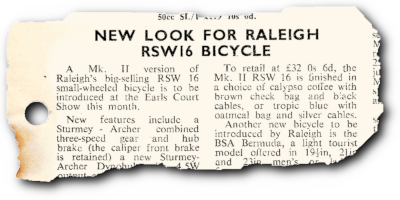
The RSW16 MkII (Raleigh Small Wheel bicycle) was launched at the 1967 Earls Court Show in Calypso Coffee with a brown check bag and black cables, or Tropic Blue with an Oatmeal bag and silver cables. We don’t know how long Calypso was active on the RSW16 MkII, but by 1975 the RSW16 was only being listed in Sky Blue with a blue check bag, though Calypso Coffee was still being used on the Raleigh Twenty AW.
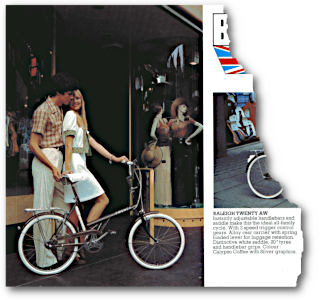
Calypso Coffee Raleigh Twenty AW
Calypso Coffee was discontinued on the RM9 after just three months, leaving the Royal Carmine Red to continue alone from March 1968 up to discontinuance of the RM9 and +1 models in September 1969.
Calypso Coffee was the briefest of any Raleigh moped production colour schemes, which was seemingly only applicable to RM9 and +1 models, and we’ve never seen any factory released promotional illustration of this finish. Our featured 9+1 is the only Calypso Coffee scheme bike that we have ever actually seen, and it’s fair to say that original examples are probably pretty rare.
The Calypso Coffee colour is a deep brown gloss with a fine gold metallic flake, and looks somewhat like a glass of Guinness with glowing golden bubbles.
An updated price listing posted on 23 November 1968 showed RM6 (standard Runabout) at £64–8s–11d, RM6 Super De Luxe at £68–17s–10d, RM8 at £74–8–11d, RM9 at £81–13–4d, and RM9+1 at £86–13s–4d as the most expensive model of the Runabout family.
RM9+1 was declared discontinued in September 1969, along with the RM5, Wisp, RM8, and RM9, and only the RM6 Runabout continued to February 1971.
So back to our title, and why does 9+1 not = 10?
This is why…
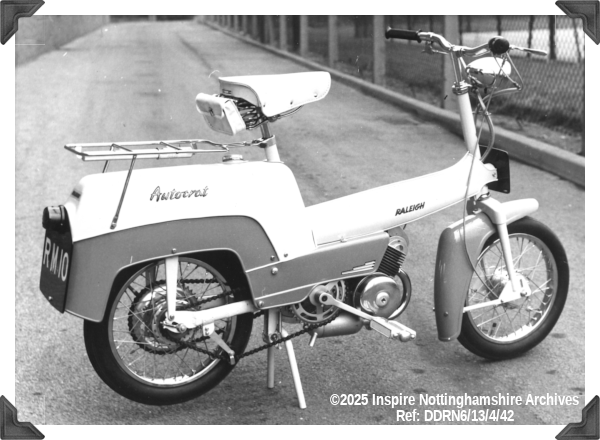
The real RM10 was a small-wheel prototype from the Wisp family, which never went into production.
It might have been a close call by the marketing department, because unlike the RM3, this RM10 had even progressed enough to be given the model name of ‘Autocrat’ … so what can we tell you about it?

The single-speed engine has the early continuous-fin 1.4bhp cylinder, which was replaced in November 1965. The engine might be an indicator that the RM10 was evolving around this time, along with the R16 Poweride and Wisp, since the Autocrat employs a number of features common to both the other models, which seemed to be coming together around 1966.
Autocrat has the same Wisp rear wheel with a 44T rear sprocket. The front wheel is built on an 80mm Atom alloy hub (as used on RM8 & RM9), which was 36-hole and would have been laced into the Wisp rear rim, then fitted in a different and essentially wider rigid front fork to enable the fitment of the hub.
The handlebar set and headlamp look to be taken straight from RM6.
It uses a Wisp pedal chain-wheel set, but displays a ‘fixed’ pedal chain tensioner arm, where the Wisp had a sprung pedal chain tensioner arm.
It seems to use the same ‘U’ form Wisp stand bracket and stand.
The frame section to the rear dropout is different from the Wisp, and the bolt-in vertical upright on the Autocrat is in stark contrast to the welded-in tubular angle stay. It appears like an upmarket Wisp, though with a different rigid frame, now covered by panels, and the fuel filler behind the nearside of the seat post, with the tank presumably somewhere within the panel.
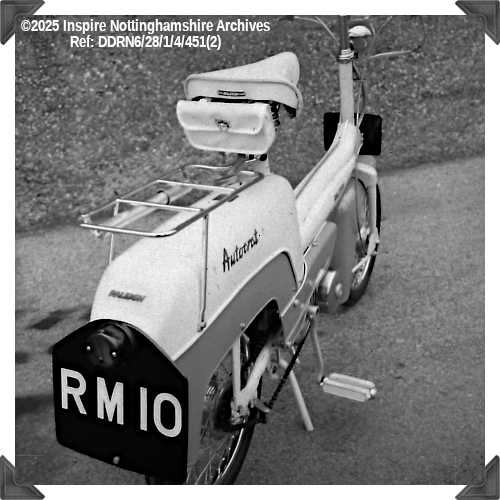
The frame panels appear to be typical Test & Development sheet metal fabrications, but we’re not sure about the front mudguard, maybe a fibreglass moulding?
In much the same manner that the R16 Poweride prototype seemed to be an economy evolution of the Wisp, the RM10 Autocrat prototype seemed to be upmarket version of the Wisp, which looked as if Raleigh might have been considering a Wisp ‘family’ of models, and it’s likely that all three were under consideration at much the same time around 1966.
This concept could be related back to what they did earlier with the Phillips Panda Mk3 (budget version), Norman Nippy Mk5 (mid-priced), and Raleigh RM4 (top of the range). The same three-level approach was also applied to the Phillips Gadabout Mk4 (budget version), Norman Lido Mk3 (mid-priced), and Raleigh RM5 Supermatic (top of this range). So Raleigh had already firmly established the approach of ‘three grades of models in a range’ following the introduction in Feb 1961 of RM4 and RM5 were joined by their other respective family members, until the Phillips and Norman models were ended in 1963.
Beyond the RM4 & 5, they also went on to a similar approach with the RM6 from the original base green/pearl grey ‘Runabout’ model, which changed to Neptune Blue for 1966, also progressed to a De Luxe version in July 1966 with an economy black ‘Pop’ in October, and a further evolution to Super De Luxe at the end of the year. 1967 saw another colour change to Royal Blue, and the ‘Pop’ discontinued in February. Beyond which, the Runabout family was also extended by the RM8, RM9, and RM9+1, so Raleigh was really into this practice of producing variations on a theme.
It should be no surprise that they were also looking at ‘level versions’ of the Wisp—it should probably be more of a surprise that none of the other versions reached production!
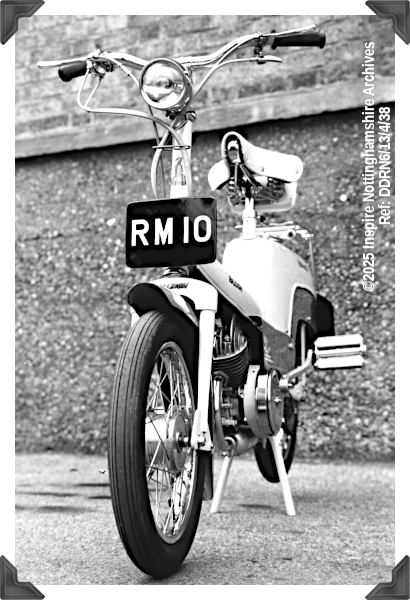
It did seem odd though that the Autocrat had its own project code of RM10, while it’s presumed that the R16 Poweride came under the auspices of the RM7 Wisp project. We guess the RM10 project was probably entered a little later, and at much the same time as the RM11 and RM12, which listed from June 1965, so began some time earlier.
The only conclusion being that the RM7 project came first, then somebody thought they wanted a further small-wheel upmarket version, which was added as RM10, but never made it through to production.
Since the Autocrat doesn’t seem to have been registered, we could speculate that the RM10 photographs may have been taken somewhere within the Raleigh works, probably within proximity of the R&D department.


